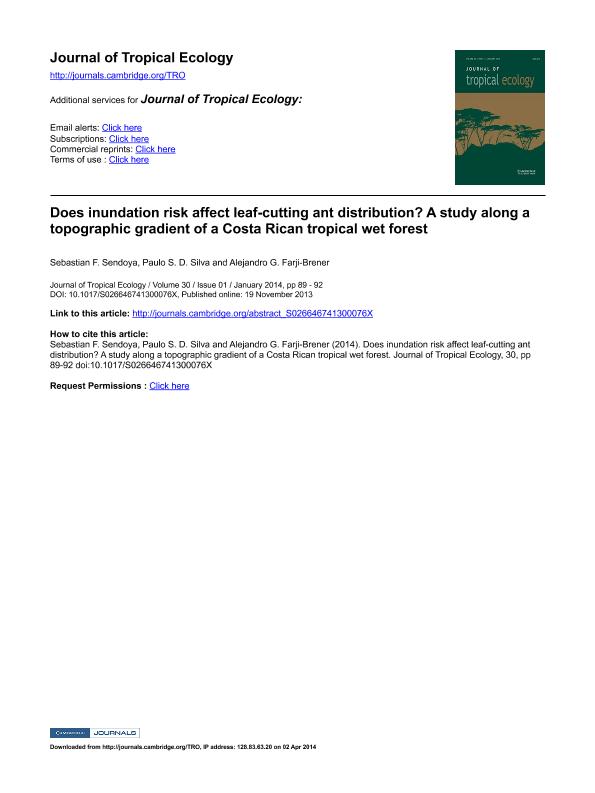Mostrar el registro sencillo del ítem
dc.contributor.author
Silva, Paulo S. D.
dc.contributor.author
Sendoya, Sebastian F.
dc.contributor.author
Farji Brener, Alejandro Gustavo

dc.date.available
2017-01-19T20:22:19Z
dc.date.issued
2014-01
dc.identifier.citation
Silva, Paulo S. D.; Sendoya, Sebastian F.; Farji Brener, Alejandro Gustavo; Does inundation risk affect leaf-cutting ant distribution? A study along a topographic gradient of a Costa Rican tropical wet forest; Cambridge University Press; Journal Of Tropical Ecology; 30; 1; 1-2014; 89-92
dc.identifier.issn
0266-4674
dc.identifier.uri
http://hdl.handle.net/11336/11655
dc.description.abstract
Successional state of forest and availability of pioneer plants are recognized factors affecting densities of leaf-cutting ants. However little is known about how abiotic factors can shape nest distributions. We investigated the effect of topography, soil, forest successional state and inundation risk on nest density and size of Atta cephalotes colonies along streams in a tropical wet forest in Costa Rica. In each forest type, we surveyed 12 sites, each site comprising five transects (10 × 100 m) varying in topography and proximity to streambeds. We found no difference regarding nest size or density between forest types or soil consociation. Nest density varied with topographic environment, with significantly higher nest density on slope tops (farther from streambeds) and without colonies in valley bottoms (closer to streambeds). Nests found in areas affected by the last great inundation before our study were scarcer and smaller than nests in non-flooded areas. We showed that inundation events favour an accumulation of Atta colonies towards higher sites, where they are also allowed to become larger and may survive longer. Inundation risk may be a strong force shaping the distribution of leaf-cutting ant nests in tropical floodplain forests, even concealing the relevance of successional state of forest.
dc.format
application/pdf
dc.language.iso
eng
dc.publisher
Cambridge University Press

dc.rights
info:eu-repo/semantics/openAccess
dc.rights.uri
https://creativecommons.org/licenses/by-nc-sa/2.5/ar/
dc.subject
Ant Abundance
dc.subject
Ant Nests
dc.subject
Disturbance
dc.subject.classification
Ecología

dc.subject.classification
Ciencias Biológicas

dc.subject.classification
CIENCIAS NATURALES Y EXACTAS

dc.title
Does inundation risk affect leaf-cutting ant distribution? A study along a topographic gradient of a Costa Rican tropical wet forest
dc.type
info:eu-repo/semantics/article
dc.type
info:ar-repo/semantics/artículo
dc.type
info:eu-repo/semantics/publishedVersion
dc.date.updated
2016-12-12T14:20:25Z
dc.journal.volume
30
dc.journal.number
1
dc.journal.pagination
89-92
dc.journal.pais
Reino Unido

dc.journal.ciudad
Cambridge
dc.description.fil
Fil: Silva, Paulo S. D.. Universidade Estadual de Campinas; Brasil
dc.description.fil
Fil: Sendoya, Sebastian F.. Universidade Estadual do Sudoeste da Bahia; Brasil
dc.description.fil
Fil: Farji Brener, Alejandro Gustavo. Consejo Nacional de Investigaciones Científicas y Técnicas. Centro Científico Tecnológico Patagonia Norte. Instituto de Investigación en Biodiversidad y Medioambiente; Argentina. Universidad Nacional del Comahue; Argentina
dc.journal.title
Journal Of Tropical Ecology

dc.relation.alternativeid
info:eu-repo/semantics/altIdentifier/url/https://www.cambridge.org/core/journals/journal-of-tropical-ecology/article/does-inundation-risk-affect-leaf-cutting-ant-distribution-a-study-along-a-topographic-gradient-of-a-costa-rican-tropical-wet-forest/45D62814BFB24BD4FF9DD24075185357
dc.relation.alternativeid
info:eu-repo/semantics/altIdentifier/doi/https://doi.org/10.1017/S026646741300076X
Archivos asociados
